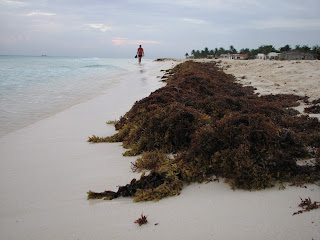I have been to some beaches: in Puri and near Mumbai in India, and a lot of places along the West coast of the USA. Nowehere have I seen seaweed pile up like it did in Playa del Carmen- and the Sisyphean effort by minimum wage workers to make it magically disappear on a daily basis. Playa is on the east coast of the Yucatan Peninsula in Mexico. It is a sister city of Cancun, and is famous for the stunning white sand beaches the world over.
When we were in Playa, Sonya and I would go for a walk in the morning, early, before the sunrise to catch the spectacular free nature show. From an hour before sunrise, to half an hour afterwards, the sky is painted by the clouds and the sun in surreal colours- ranging from the colours of a delicate pink rose petal to the bright orange of a ripe papaya.
 |
| The sun rises beyond the clouds, illuminating the seaweed that washed up overnight on the beach, while the ferry patiently waits to take its load to Isla Cozumel, a small island en el Mar de Caribe. |
While we were indulging our senses on the near deserted beach, there would be crews of men on the beach working with the seaweed. Most of them worked long sections of the beach in front of each hotel. They would dig trenches in beach, bury the seaweed in the trenches, and finally pile more sand on top to create a pristine sand beach for the postcards of the tourists.
 |
| Digging a pit for the seaweed |
There were also people who would comb the beach towing a large plastic garbage bag- cleaning the beach by hand; they tossed in the daily trash of the beach: plastic water bottles, beer bottles, cans, pieces of plastic that had been swept ashore- and none of this was weighed and measured in pounds and hours and humans like the volunteer beach cleanups in Oregon- the state in the USA where I lived.
 |
| Hauling away trash from the beach as a minimum wage job. |
As per the website: http://www.solv.org/ , this is what volunteers cleaned up on a single day
"Thank you to the over 3,744 volunteers who headed to the Oregon Coast for the 2012 SOLVE Spring Oregon Beach Cleanup to clean up trash washed ashore by winter storms. Armed with raingear, gloves, bags, buckets, and colanders volunteers removed an estimated 60,483 total pounds of trash from our beaches including 1,565 pounds of recycled and re-used materials and 55 tires. The most common item reported up and down the coast was bite-sized pieces of plastic. Other common items reported included cigarette butts (which also contain plastic), bottle caps, bags, ropes, Styrofoam, and tires."
Some of the bigger hotels had larger earth-moving equipment that are custom built for this operation: one was like a combined harvester- it would chow down the sand- seaweed and all, parse it its stomach, drop the sand back on the beach, while the seaweed would be deposited in a trailer following it like a loyal attendant.
 |
| The work crew working along the machines. |
 |
| An ATV hauls trash. |
In addition to being an eyesore for tourists, it makes it harder to walk on the beach, and the seaweed smells like the ocean- a natural smell no doubt- but one that is disgusting to many people (and one that I as a fish-eater know- it is the smell of the ocean that some complain about when fish is cooked). Is it correct for us to consider seaweed as simply weed? I am not sure of the ecological consequences of doing this. For one, sea-birds may have a harder time finding food. And just down the coast are protected reserves for endangered sea turtles- my guess is that this beach was turtle heaven not a long time ago.
How much of nature can we manipulate for our needs? Is it OK to manipulate 5km of beach along Playa if it brings in the tourists and is good for business and jobs, while we leave 100km of "wild" beach for nature? If the beaches were not emptied of the seaweed, the tourists would go elsewhere.
It makes one think about how we take care of the commons, for the beaches in Mexico are open to the public and no one can own the beach, unlike places in India and the USA. Should the responsibility of taking care of the beach be that of the government, volunteers, the local people or a private agency? It also involves questions about workers benefits like health care and pension, for these workers are minimum wage workers, and other issues like gender roles and immigration.
 |
| One of the "insignificant to humans" seabirds, that is part of a flock that look for food in the seaweed. |
It makes me ponder about a natural experience- what could be more natural than going to the beach- nothing but the sun, the sea, the sand and the self- when we have to tailor the experience to make it palatable for humans.
 |
| The beach an hour after sun-rise; no malodourous eyesore seaweed to impinge on our senses. |







































